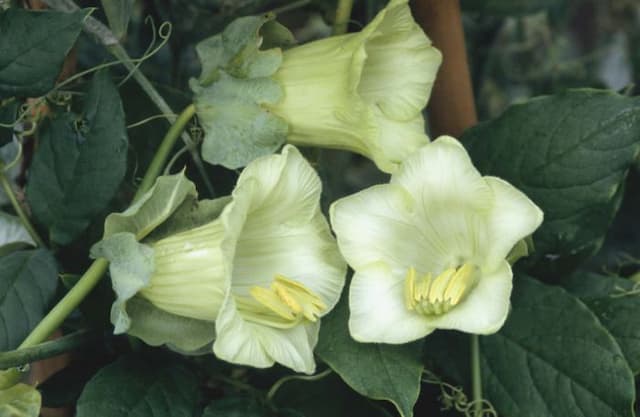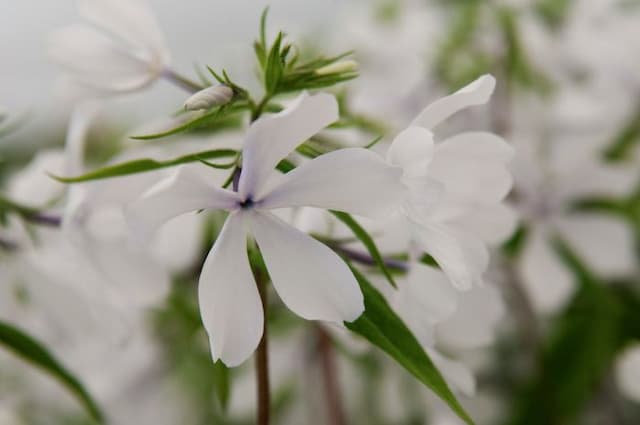Garden Phlox Phlox × arendsii 'Miss Mary' (Spring Pearl Series)

ABOUT
Phlox 'Miss Mary' from the Spring Pearl Series is a visually appealing perennial plant known for its attractive floral display. The plant produces clusters of flowers that provide a vibrant splash of color in the garden. Each individual flower is tubular and flared with five petal-like lobes, showing an enchanting shade that often ranges from soft to more vivid hues. The blooms are typically concentrated at the top of the stems, creating a dense bouquet-like effect that is both lush and eye-catching. The leaves are lance-shaped and arranged in a pattern that can be either opposite or whorled on the stems, contributing to a full and verdant backdrop for the brightly colored flowers. This green foliage, while not as showy as the blooms, adds a calming contrast and highlights the striking nature of the flower clusters. Phlox 'Miss Mary' is appreciated for its extended blooming period, which brings an enduring sense of charm to gardens. The plant often continues to contribute its alluring colors throughout its blooming season, attracting pollinators such as butterflies and hummingbirds. Overall, Phlox 'Miss Mary' offers a delightful and classic garden presence with its abundant flowering and charming palette.
About this plant
 Names
NamesFamily
Polemoniaceae
Synonyms
Hybrid Spring Phlox, Arend's Phlox, Garden Phlox
Common names
Phlox × arendsii 'Miss Mary' (Spring Pearl Series).
 Toxicity
ToxicityTo humans
The Garden Phlox plant, in general, is not known to be toxic to humans. There is no significant evidence to suggest that Phlox × arendsii 'Miss Mary' or any cultivars within the Spring Pearl Series contain toxins that would cause harm if ingested. However, as a precautionary principle, it is not advisable to ingest any ornamental plants due to potential individual sensitivities or the possible presence of garden chemicals.
To pets
Similar to its effects on humans, the Garden Phlox is not considered toxic to pets. Phlox × arendsii 'Miss Mary' and other members of the Spring Pearl Series are not known to contain substances that are poisonous to dogs, cats, or other household pets. Ingestion of plant material may cause mild gastrointestinal upset in some animals due to the unusual plant matter in the diet, but it is not expected to cause serious or lasting illness.
 Characteristics
CharacteristicsLife cycle
Perennials
Foliage type
Deciduous
Color of leaves
Green
Flower color
Pink
Height
1-2 feet (30-60 cm)
Spread
1-2 feet (30-60 cm)
Plant type
Herb
Hardiness zones
4-8
Native area
North America
Benefits
 General Benefits
General Benefits- Aesthetic Appeal: Phlox × arendsii 'Miss Mary' provides a vibrant display of pink flowers that add color and visual interest to gardens and landscapes.
- Ease of Cultivation: This variety is known for being hardy and relatively easy to grow in various soil types and garden conditions.
 Medical Properties
Medical PropertiesThis plant is not used for medical purposes.
 Air-purifying Qualities
Air-purifying QualitiesThis plant is not specifically known for air purifying qualities.
 Other Uses
Other Uses- Garden photography backdrop: With its brilliant blooms, Phlox can serve as an excellent backdrop for photographers looking to capture the essence of spring in a garden setting.
- Edible flower garnish: The florets of Phlox can be used as a colorful edible garnish for salads and desserts, though they should be eaten in moderation due to their intense flavor.
- Natural dye source: The pigments from Phlox petals can be used to create natural dyes for fabrics, offering a range of pink hues.
- Floral art and crafts: The colorful flowers of the Phlox are suitable for use in floral crafts, such as making bookmarks, pressed flower arrangements, or potpourri.
- Culinary experiments: Some adventurous chefs use small amounts of Phlox flowers to infuse vinegar or create unique floral-flavored syrups for use in specialty cocktails.
- Plant-based ink ingredient: Crushed petals of Phlox can potentially be used to make plant-based inks for writing or drawing.
- Fragrance extraction: Though not a common method, the scent of Phlox flowers could be captured in the form of an essential oil or hydrosol for use in homemade perfumes or aromatic products.
- Teaching tool in horticulture: Phlox is commonly used to teach plant identification and gardening techniques due to its distinct growth habits and popularity among gardeners.
- Wildlife habitat creation: By planting Phlox in the garden, you can create a habitat appreciated by hummingbirds, bees, and butterflies, thereby supporting biodiversity.
- Symbolism in cultural events: In some contexts, Phlox may be used as a symbol of unity or sweet dreams, and can be incorporated into cultural or religious ceremonies reflecting this symbolism.
Interesting Facts
 Feng Shui
Feng ShuiThe Garden Phlox is not used in Feng Shui practice.
 Zodiac Sign Compitability
Zodiac Sign CompitabilityThe Garden Phlox is not used in astrology practice.
 Plant Symbolism
Plant Symbolism- Harmony: Phlox flowers represent harmony and balance, due to their clustered growth and uniform appearance, which reflects well-coordinated unity.
- Agreement: Given their harmonious nature, phlox can symbolize agreement and the coming together of minds, making it a suitable gift for reaching consensus.
- Partnership: Phlox can also signify partnership, with its dense clusters symbolizing a strong bond and companionship between individuals.
- Proposal: In the language of flowers, phlox is sometimes associated with the idea of a proposal or an offer extended from one person to another with positive intentions.
 Water
WaterTall Phlox or Garden Phlox should be watered deeply and thoroughly, ensuring the water penetrates the soil to reach the roots. During the growing season, water approximately once a week, depending on weather conditions. If rainfall is less than an inch per week, provide supplemental watering by adding about one gallon of water per square foot of garden bed. Overhead watering should be avoided to prevent powdery mildew; instead, water at the base of the plants early in the day. In hot, dry periods, additional watering may be necessary to maintain moist but not waterlogged soil.
 Light
LightGarden Phlox thrives in full sun, which means it needs at least six hours of direct sunlight each day. The ideal location is a spot that receives morning sun and some afternoon shade, particularly in hotter climates, to protect from harsh late-day rays. These plants can tolerate partial shade, but flowering may be diminished and the risk of fungal diseases can increase in less sunny conditions.
 Temperature
TemperatureGarden Phlox prefers a temperate climate with temperatures ranging between 60°F and 85°F for optimal growth. It can survive winter temperatures down to about -30°F, making it suitable for many temperate regions. During the summer, the ideal growing conditions will have daytime temperatures under 85°F and cooler nighttime temperatures, which help the plant recover from heat stress.
 Pruning
PruningGarden Phlox benefits from pruning to promote vigorous growth and prevent disease. After the first bloom in early summer, cut back the flower stems by one-third to encourage a second bloom. Remove dead or diseased stems anytime they are noticed. The best time for major pruning is in late winter or early spring before new growth begins.
 Cleaning
CleaningAs needed
 Soil
SoilGarden Phlox prefers a rich, well-drained soil with a slightly alkaline pH of 6.5 to 7.0. A good soil mix for Garden Phlox 'Miss Mary' would include loamy garden soil, compost, and perlite to ensure good drainage and fertility.
 Repotting
RepottingGarden Phlox 'Miss Mary' generally does not require frequent repotting and can be repotted every 2-3 years or when the plant has outgrown its container.
 Humidity & Misting
Humidity & MistingGarden Phlox 'Miss Mary' thrives in average garden humidity levels, without the need for any special humidity requirements.
 Suitable locations
Suitable locationsIndoor
Place in well-lit spot, ensure good air flow.
Outdoor
Plant in sunny area with well-drained soil.
Hardiness zone
4-8 USDA
 Life cycle
Life cyclePhlox × arendsii 'Miss Mary', commonly known as Garden Phlox, begins its life cycle as a seed, typically sown in early spring or after the danger of frost has passed. Upon germination, the seedlings emerge and grow into young plants with foliage that forms a low-growing rosette. As the temperatures warm, the plant enters a vigorous vegetative stage, with stems elongating and leaves maturing. By mid to late summer, the Garden Phlox reaches the flowering stage, producing clusters of fragrant, vibrant blooms that attract pollinators such as butterflies and bees. Following pollination, the flowers develop into small fruit containing seeds, which can be dispersed to start a new generation. The plant then enters dormancy during the cold winter months, withstanding frost and snow, to reemerge the following spring.
 Propogation
PropogationPropogation time
Spring
Phlox × arendsii 'Miss Mary' (Spring Pearl Series), commonly known as Garden Phlox, is typically propagated by stem cuttings. The best time to take cuttings for propagation is in late spring or early summer when the plant is actively growing. To propagate Garden Phlox by cuttings, a gardener should select a healthy stem with several sets of leaves. They would cut a segment about 4 to 6 inches (approximately 10 to 15 centimeters) in length, just below a set of leaves, and remove the lower leaves to expose the nodes. The cut end can be dipped in rooting hormone to encourage root development and then inserted into a moist potting mix. The cutting should be kept in indirect light and the soil should be kept consistently moist but not waterlogged until roots have developed and new growth is apparent.









